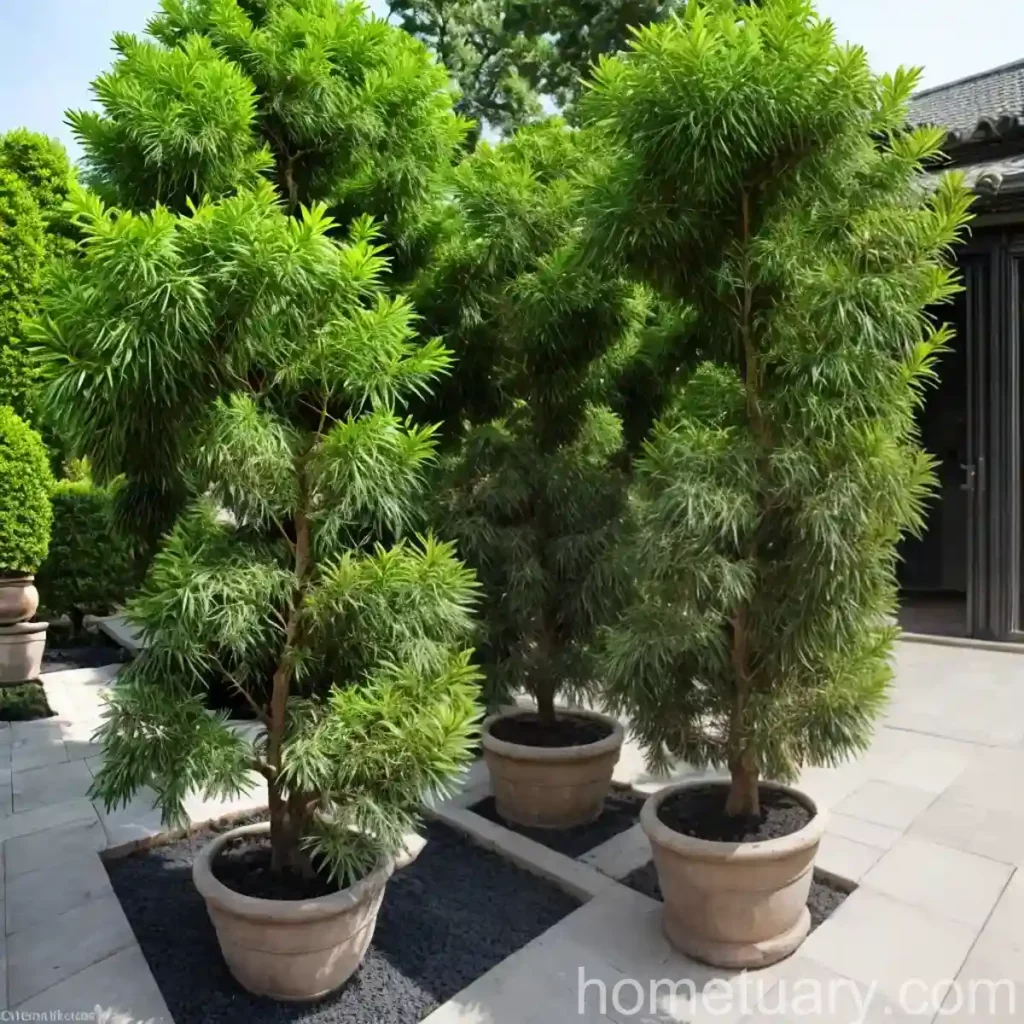Chinese Plum Yew (Cephalotaxus fortunei)
Introduction
Cephalotaxus fortunei, commonly known as Chinese plum yew, is an evergreen shrub with a rich history of use in traditional Chinese medicine and landscaping. Its unique foliage and hardy nature make it a popular choice for gardens and urban landscapes. In this comprehensive guide, we will explore the key characteristics of Chinese plum yew, its cultivation, uses, and tips for maintaining its health.
What is Chinese Plum Yew (Cephalotaxus fortunei)?
Cephalotaxus fortunei, belonging to the Cephalotaxaceae family, is native to western China. It is a slow-growing, dense, and compact evergreen shrub characterized by dark green foliage and a conical growth habit. Although it is called a ‘plum yew,’ it is not a true yew (Taxus) but is closely related. This plant is dioecious, meaning it has separate male and female plants, with the female plants bearing attractive red, plum-like fruits.
The genus name “Cephalotaxus” is derived from the Greek words “kephale” meaning head and “taxis” meaning arrangement, referring to the tufted arrangement of leaves at the ends of the branches. The species name “fortunei” honors Robert Fortune, a Scottish botanist known for introducing numerous plant species from China to the Western world.
Key Takeaways – Chinese Plum Yew (Cephalotaxus fortunei)
- Scientific Name: Cephalotaxus fortunei
- Common Names: Chinese Plum Yew, Plum Yew
- Family: Cephalotaxaceae
- Plant Type: Evergreen shrub
- Native Habitat: China
- Growth Rate: Slow
Characteristics of Chinese Plum Yew
Chinese plum yew possesses several notable characteristics that make it a desirable plant for both ornamental and medicinal purposes. Here are some key features of this plant:
Foliage
The foliage of Chinese plum yew is dark green, glossy, and needle-like, similar to that of true yews. The arrangement of the leaves in tufts gives the plant a unique appearance, adding to its ornamental value.
Growth Habit
The plant has a slow growth rate and typically forms a dense, conical shape. It can reach a mature height of 10-20 feet and a spread of 6-10 feet, making it an excellent choice for hedges or foundation plantings.
Fruits
Female Chinese plum yew plants produce attractive, fleshy, red fruits that resemble small plums. These fruits add visual interest to the plant and are used in traditional Chinese medicine.
Growing Chinese Plum Yew
Sunlight Needs
Chinese plum yew thrives in partial to full shade, making it an ideal choice for areas with limited direct sunlight. However, it can tolerate some sun if the soil is consistently moist.
Hardiness Zones
The plant is suitable for hardiness zones 6 to 9, where it can withstand a range of temperatures and climatic conditions.
Soil Requirements
Chinese plum yew prefers well-draining, slightly acidic to neutral soil. It is adaptable to various soil types, including loamy, sandy, and clay soils.
Water Requirements
While Chinese plum yew is drought-tolerant once established, it benefits from regular watering, especially during dry periods. It is essential to ensure that the soil remains moist but not waterlogged.
Chinese Plum Yew Care
Proper care is essential for the health and vigor of Chinese plum yew plants. Here are some guidelines for maintaining these plants:
Fertilization
Fertilize Chinese plum yew in spring with a balanced, slow-release fertilizer to support healthy growth. Avoid using excessive amounts of nitrogen, as it can lead to rapid, weak growth.
Pruning
Minimal pruning is required for Chinese plum yew, mainly to maintain its shape and remove any damaged or diseased branches. Pruning is best performed in late winter or early spring before new growth emerges.
Benefits of Chinese Plum Yew
The Chinese plum yew offers various benefits, both practical and aesthetic, making it a valuable addition to gardens and landscapes. Some of its benefits include:
- Ornamental Value: The dense, dark green foliage and attractive red fruits add aesthetic appeal to gardens and landscapes.
- Medicinal Uses: The fruits and leaves of Chinese plum yew have been used in traditional Chinese medicine to treat various ailments.
- Wildlife Habitat: The plant provides cover and food for birds, making it an ecologically valuable addition to naturalized areas.
- Low Maintenance: Its slow growth rate and minimal care requirements make it a low-maintenance plant for landscaping.
Chinese Plum Yew Varieties
Several varieties and cultivars of Chinese plum yew are available, offering diverse foliage colors, growth habits, and sizes. Some popular varieties include:
- Cephalotaxus fortunei ‘Prostrata’: This variety has a prostrate growth habit, making it suitable for ground cover and cascading plantings.
- Cephalotaxus fortunei ‘Duke Gardens’: It is a compact form with a dense, upright growth habit, ideal for small gardens and urban landscapes.
- Cephalotaxus fortunei ‘Nana’: This dwarf variety has a slow growth rate and a low, spreading habit, making it suitable for rock gardens and borders.
Chinese Plum Yew Cultivation
Cultivating Chinese plum yew is relatively straightforward, and the plant’s adaptability to various growing conditions makes it suitable for different landscapes. Here are some cultivation tips:
- Choose a shaded or partially shaded location for planting.
- Ensure well-draining soil by amending heavy or compacted soil with organic matter.
- Water newly planted Chinese plum yew regularly to help with establishment.
- Mulch around the base of the plant to retain soil moisture and suppress weed growth.
Chinese Plum Yew Landscaping
Chinese plum yew is a versatile plant that can be used in various landscaping scenarios, including:
- Shade Gardens: Its preference for partial to full shade makes it an excellent choice for creating lush, green environments in shaded areas.
- Japanese Gardens: The compact, conical growth habit and attractive foliage make it a suitable addition to serene and contemplative Japanese garden designs.
- Urban Landscapes: The low-maintenance nature of the plant, coupled with its adaptability to urban conditions, makes it an ideal choice for city landscapes and public green spaces.
Chinese Plum Yew Uses
Ornamental Planting
Chinese plum yew is widely used as an ornamental plant in gardens, parks, and commercial landscapes. Its attractive foliage and resilience to shade make it a popular choice for creating greenery in areas with limited sunlight.
Medicinal Properties
In traditional Chinese medicine, the fruits and leaves of Chinese plum yew are used to prepare tonics and remedies for various ailments, including digestive issues and respiratory conditions. However, it is essential to consult a qualified healthcare practitioner before using any plant-based remedies.
Chinese Plum Yew Pruning
Pruning Chinese plum yew is typically minimal and focused on maintaining the plant’s shape and removing dead or damaged growth. Here are some pruning techniques to consider:
- Selective Pruning: Remove any dead, diseased, or damaged branches regularly to promote overall plant health.
- Shaping: Prune the plant lightly to maintain its natural conical shape and prevent it from becoming leggy.
Chinese Plum Yew Diseases
Chinese plum yew is relatively resistant to most diseases, especially when grown in favorable conditions. However, some factors can predispose the plant to certain issues, including:
- Root Rot: Overly wet soil can lead to root rot, especially in poorly draining soil.
- Needle Blight: This fungal disease can affect the foliage of Chinese plum yew, leading to discoloration and premature leaf drop.
- Powdery Mildew: In humid conditions, the plant may be susceptible to powdery mildew, which can affect the health and appearance of the foliage.
Disease Diagnosis
Diagnosing diseases in Chinese plum yew involves careful observation of the plant’s overall health and specific symptoms such as browning or yellowing of foliage, abnormal growth, or the presence of powdery coatings on leaves. If significant issues arise, consulting with a plant health specialist is advisable for proper diagnosis and management.
Chinese Plum Yew Pests
While Chinese plum yew is relatively resistant to pests, it may occasionally face infestations from certain insects. Common pests that can affect Chinese plum yew include:
- Scale Insects: These pests can appear as small, immobile bumps on the stems or foliage, leading to weakened growth and general decline.
- Spider Mites: In hot and dry conditions, spider mites may infest the plant, causing stippling and discoloration of the leaves.
Botanist’s Tips
To ensure the health and vitality of Chinese plum yew, consider the following tips:
- Monitor soil moisture and avoid overwatering, especially in poorly draining soil.
- Regularly inspect the foliage for signs of pest infestations and take appropriate measures if necessary.
- Provide adequate airflow around the plant to prevent the development of fungal diseases, especially in humid conditions.
Fun Facts
Explore some intriguing and lesser-known facts about Chinese plum yew:
- The leaves and seeds of the plant are used in traditional Chinese medicine for their purported medicinal properties, including as a digestive aid and for relieving coughs.
- Chinese plum yew is a dioecious plant, meaning that individual plants are either male or female, with the female plants bearing the attractive plum-like fruits.
- The plant’s slow growth rate and dense foliage make it an excellent option for creating low-maintenance hedges and privacy screens.
Links to External Resources
For further information about Chinese plum yew, its cultivation, and landscape uses, consider exploring the following resources:
- The American Conifer Society
- The Royal Horticultural Society
- Missouri Botanical Garden
- The American Society of Plant Biologists
In conclusion, the Chinese plum yew (Cephalotaxus fortunei) offers a myriad of benefits as an ornamental plant and has a rich cultural history due to its traditional medicinal uses. Its adaptability to various landscape settings, low maintenance requirements, and unique foliage make it an attractive choice for both amateur and experienced gardeners. By understanding the plant’s needs and characteristics, enthusiasts can successfully cultivate and enjoy the beauty and practical uses of this fascinating evergreen shrub.















